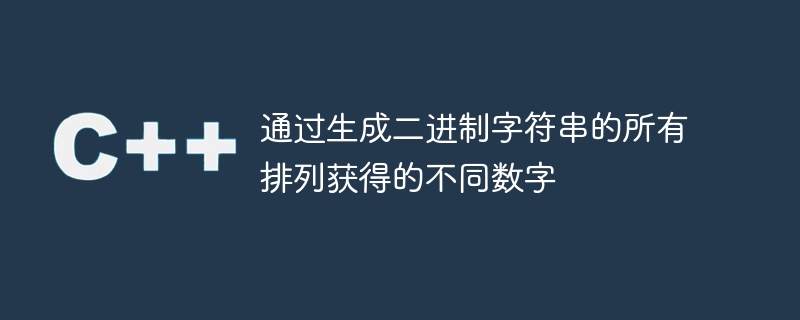透過產生二進位字串的所有排列所獲得的不同數字

問題陳述
我們給定了長度為 N 的二進位字串 str。我們需要找到該字串的所有排列,將它們轉換為十進制值,並傳回所有唯一的十進制值。
範例
輸入
str = ‘1’
輸出
[1]
說明
「1」的所有排列都只是「1」。因此,與「1」相關的十進制值等於 1。
輸入
str = ‘10’
輸出
[1, 2]
說明
‘10’的排列只有‘01’和‘10’,分別相當於1和2。
輸入
‘101’
輸出
[3, 5, 6]
說明
“101”的所有可能排列是“110”、“101”、“110”、“011”、“101”和“011”,如果我們將它們轉換為十進制數字,我們會得到3、5 ,以及6 個唯一的十進制數。
方法 1
在第一種方法中,我們將使用回溯來取得二進位字串的所有排列。之後,我們將二進制排列轉換為十進制值,並使用該集合選擇唯一的十進制值。我們將使用 pow() 方法和 for 迴圈將十進位轉換為二進位。
演算法
第 1 步 - 定義「getDecimalPermutations()」函數以取得結果十進位值。
第 2 步 - 執行「getBinaryPermutations()」函數以取得字串的所有二進位排列。另外,也傳遞字串、左右索引和排列向量作為參數。
步驟 2.1 - 在「getBinaryPermutations()」函數中,如果左右索引相等,則將結果字串推送到排列清單中。
步驟 2.2 - 如果左右索引不相等,則使用 for 迴圈從左索引到右索引迭代字串。
步驟 2.3 - 在 for 迴圈中交換第 i 個索引和左側索引處的字元。
步驟 2.4 - 再次使用與參數相同的參數和「left 1」索引來呼叫「getBinaryPermutations」函數。
步驟 2.5 - 交換第 i 個索引和左側索引處的字元以實現回溯目的。
第 3 步 - 建立一個名為「allDecimals」的集合。之後,迭代二進位字串的所有排列。
第 4 步 - 呼叫 bToD() 函數將二進位轉換為十進位。
步驟 4.1 - 在 bToD() 函數中,以 0 值初始化十進位變數。
步驟4.2 - 使用for 循環從末尾開始迭代二進位字串,並添加'(num[i] - '0') * pow(2, j )' 轉換為十進制值。
步驟 4.3 - 傳回十進位值。
第 5 步 - 在「getDecimalPermutations」函數中,插入從 bToD() 函數傳回的十進位值。
第 6 步 - 列印該集合的所有值,其中將包含唯一的十進位值。
範例
#include <iostream>
#include <bits/stdc++.h>
using namespace std;
// Function to convert binary to decimal
int bToD(string num){
int decimal = 0;
for (int i = num.size() - 1, j = 0; i >= 0; i--, j++){
decimal += (num[i] - '0') * pow(2, j);
}
return decimal;
}
// Function to get all permutations of a binary string
void getBinaryPermutations(string str, int left, int right, vector<string> &permutations){
// Base case
if (left == right){
// push_back() function is used to push elements into a vector from the back
permutations.push_back(str);
} else {
// Permutations made
for (int i = left; i <= right; i++){
// Swapping done
swap(str[left], str[i]);
// Recursion called for next index (left + 1)
getBinaryPermutations(str, left + 1, right, permutations);
// Backtrack
swap(str[left], str[i]);
}
}
}
void getDecimalPermutations(string str){
vector<string> permutations;
getBinaryPermutations(str, 0, str.length() - 1, permutations);
set<int> allDecimals;
for (const auto &p : permutations){
allDecimals.insert(bToD(p));
}
cout << "All decimal numbers which we can achieve using permutations are " << endl;
for (const auto &d : allDecimals){
cout << d << " ";
}
}
int main(){
string bString = "101";
getDecimalPermutations(bString);
return 0;
}
輸出
All decimal numbers which we can achieve using permutations are 3 5 6
時間複雜度 - O(n!)。 “getBinaryPermutations()”函數的時間複雜度是“n!”,因為我們使用回溯來尋找所有排列。 bToD() 函數的時間複雜度為 O(n)。
空間複雜度 - O(n!)。每個字串都有 n!我們儲存在列表中的排列。
方法2
在這個方法中,我們將使用 C 的 next_permutation() 函數來產生二進位字串排列,而不是回溯方法。此外,我們也更改了將二進制轉換為十進制的方法。
演算法
第 1 步 - 定義「allNumbers」集合。
步驟 2 - sort() 方法用於對二進位字串進行排序。
第 3 步 - 使用 do-while 迴圈迭代字串的每個排列。
步驟 4 - 在 do-while 迴圈中,透過傳遞字串作為參數來呼叫 bToD() 函數,以將二進位轉換為十進位數字。
步驟 4.1 - 在 bToD() 函數中,定義「currentBase」變數並將其初始化為 1。
步驟 4.2 - 使用 for 循環,並從最後一個索引開始迭代字串。
步驟4.3 - 在for迴圈中,如果目前字元等於'1',我們需要將currentBase值加到'decimal_number'。
< /里>步驟 4.4 - 將 currentBase 乘以 2。
第 5 步 - 將十進位數插入「allNumber」集中。
第 6 步 - 在 do-while 循環的條件下使用 next_permutation() 方法,因為如果字串的下一個排列存在,它將傳回 true。
第 7 步 - 列印「allNumbers」中新增的所有數字,以獲得與給定二進位字串的所有排列相關的唯一十進制數。
示例
#include <iostream>
#include <algorithm>
#include <set>
using namespace std;
int bToD(string num){
int decimal_number = 0;
// Initializing base value to 1, and it increases by power of 2 in each iteration
int currentBase = 1;
for (int i = num.length() - 1; i >= 0; i--){
if (num[i] == '1'){
decimal_number += currentBase;
}
currentBase = currentBase * 2;
}
return decimal_number;
}
void getDecimalPermutations(string str){
// create set
set<int> allNumbers;
// sort the string
sort(str.begin(), str.end());
do {
// convert binary string to decimal
int result = bToD(str);
// insert the decimal number to set
allNumbers.insert(result);
// get the next permutation
} while (next_permutation(str.begin(), str.end()));
//Print all distinct decimal numbers
cout << "All decimal numbers which we can achieve using permutations are " << endl;
for (auto num : allNumbers)
cout << num << " ";
cout << endl;
}
int main(){
string bString = "101";
getDecimalPermutations(bString);
return 0;
}
输出
All decimal numbers which we can achieve using permutations are 3 5 6
时间复杂度 - O(n*n!)。这里,next_permutations() 需要 O(n) 时间来找到一个排列,并且我们正在找到总共 n!排列。
空间复杂度 - O(n!),因为我们将所有排列存储在列表中。
结论
我们学习了不同的方法来获取通过给定二进制字符串的所有排列获得的唯一十进制值。在第一种方法中,我们使用了回溯;在第二种方法中,我们使用了 next_permutation() 方法。
第二种方法的代码更清晰,但需要更多的时间和复杂性。
以上是透過產生二進位字串的所有排列所獲得的不同數字的詳細內容。更多資訊請關注PHP中文網其他相關文章!

熱AI工具

Undresser.AI Undress
人工智慧驅動的應用程序,用於創建逼真的裸體照片

AI Clothes Remover
用於從照片中去除衣服的線上人工智慧工具。

Undress AI Tool
免費脫衣圖片

Clothoff.io
AI脫衣器

AI Hentai Generator
免費產生 AI 無盡。

熱門文章

熱工具

記事本++7.3.1
好用且免費的程式碼編輯器

SublimeText3漢化版
中文版,非常好用

禪工作室 13.0.1
強大的PHP整合開發環境

Dreamweaver CS6
視覺化網頁開發工具

SublimeText3 Mac版
神級程式碼編輯軟體(SublimeText3)

熱門話題
 C語言數據結構:樹和圖的數據表示與操作
Apr 04, 2025 am 11:18 AM
C語言數據結構:樹和圖的數據表示與操作
Apr 04, 2025 am 11:18 AM
C語言數據結構:樹和圖的數據表示與操作樹是一個層次結構的數據結構由節點組成,每個節點包含一個數據元素和指向其子節點的指針二叉樹是一種特殊類型的樹,其中每個節點最多有兩個子節點數據表示structTreeNode{intdata;structTreeNode*left;structTreeNode*right;};操作創建樹遍歷樹(先序、中序、後序)搜索樹插入節點刪除節點圖是一個集合的數據結構,其中的元素是頂點,它們通過邊連接在一起邊可以是帶權或無權的數據表示鄰
 C語言文件操作難題的幕後真相
Apr 04, 2025 am 11:24 AM
C語言文件操作難題的幕後真相
Apr 04, 2025 am 11:24 AM
文件操作難題的真相:文件打開失敗:權限不足、路徑錯誤、文件被佔用。數據寫入失敗:緩衝區已滿、文件不可寫、磁盤空間不足。其他常見問題:文件遍歷緩慢、文本文件編碼不正確、二進製文件讀取錯誤。
 在C中如何有效地使用RVALUE參考?
Mar 18, 2025 pm 03:29 PM
在C中如何有效地使用RVALUE參考?
Mar 18, 2025 pm 03:29 PM
文章討論了在C中有效使用RVALUE參考,以進行移動語義,完美的轉發和資源管理,重點介紹最佳實踐和性能改進。(159個字符)
 如何在C 20中使用範圍進行更有表現的數據操縱?
Mar 17, 2025 pm 12:58 PM
如何在C 20中使用範圍進行更有表現的數據操縱?
Mar 17, 2025 pm 12:58 PM
C 20範圍通過表現力,合成性和效率增強數據操作。它們簡化了複雜的轉換並集成到現有代碼庫中,以提高性能和可維護性。
 c語言函數的基本要求有哪些
Apr 03, 2025 pm 10:06 PM
c語言函數的基本要求有哪些
Apr 03, 2025 pm 10:06 PM
C語言函數是代碼模塊化和程序搭建的基礎。它們由聲明(函數頭)和定義(函數體)組成。 C語言默認使用值傳遞參數,但也可使用地址傳遞修改外部變量。函數可以有返回值或無返回值,返回值類型必須與聲明一致。函數命名應清晰易懂,使用駝峰或下劃線命名法。遵循單一職責原則,保持函數簡潔性,以提高可維護性和可讀性。
 如何使用C中的移動語義來提高性能?
Mar 18, 2025 pm 03:27 PM
如何使用C中的移動語義來提高性能?
Mar 18, 2025 pm 03:27 PM
本文討論了使用C中的移動語義來通過避免不必要的複制來提高性能。它涵蓋了使用std :: Move的實施移動構造函數和任務運算符,並確定了關鍵方案和陷阱以有效
 動態調度如何在C中起作用,如何影響性能?
Mar 17, 2025 pm 01:08 PM
動態調度如何在C中起作用,如何影響性能?
Mar 17, 2025 pm 01:08 PM
本文討論了C中的動態調度,其性能成本和優化策略。它突出了動態調度會影響性能並將其與靜態調度進行比較的場景,強調性能和之間的權衡







